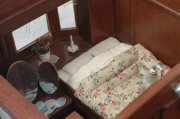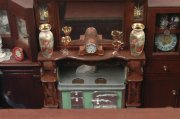LATE 1930s 24ft ROAD WAGON
 This model was built from a set of MFD plans designed by Vic King.
Normally I hate working from plans as I much prefer making it up as I go along and solving each problem as it rears it head. One of my old work colleagues had a saying "A problem is nothing more than a delayed solution", how true is that?
This model was built from a set of MFD plans designed by Vic King.
Normally I hate working from plans as I much prefer making it up as I go along and solving each problem as it rears it head. One of my old work colleagues had a saying "A problem is nothing more than a delayed solution", how true is that?
The plans concentrate on the main external structure and the interior is really left to the modeller's own preference. I was just as interested in the interior (if not more so) as the exterior so I wrote to MFD to see if they could help with the interior. Their advice was to contact someone with a similar wagon and see if they cold help. What good advice that turned out to be, as I contacted John Harris from Ashington West Sussex who showed me around his beautiful wagon and on leaving, gave me a phone number for Julian Wolfe who he thought could help me.
Since meeting John Harris I have been introduced to so many people that I now have a wealth of experience that I can call upon. I started off by following the plans exactly and had quite a bit of the model constructed before Julian introduced me to John Pockett. For those who don't know John, he is widely recognised as one of the leading authorities on the subject of living wagons, both Gipsy and Showman's as well as being a top class decorator of wagons and fairground equipment. When John first saw the model, there were a few items that he was not happy with. The main door should be the two part stable type with a glass panel panel at the top and three wooden panels at the bottom, one horizontal at the top and two vertical beneath it. The main windows should be reduced in size and the two end windows should be matching, either both as bays or both flush fitting, not one of each.
The majority of wagons from that era had the double bed running lengthwise along one of the sidewalls. In order to do this, you will have to move the door from the parlour into the bedroom, to one side instead of in the middle as shown on the plans. If you leave the door in the centre you will have to place the bed in the less common position across the end wall.
 The one area that I followed exactly as per the plans was the construction of the removable roof. This was built on a series of formers to give the shape of the Mollycroft. On a full size wagon, the roof is not removable and its strength comes from being part of the integral structure. The formers on the model present a problem because they do not exist on the real thing and it makes decorating the ceiling very difficult. I decided that I would find a solution when I made the second model and I have covered this under Techniques. I keep debating about building a new roof for this model but never seem to find the time.
The one area that I followed exactly as per the plans was the construction of the removable roof. This was built on a series of formers to give the shape of the Mollycroft. On a full size wagon, the roof is not removable and its strength comes from being part of the integral structure. The formers on the model present a problem because they do not exist on the real thing and it makes decorating the ceiling very difficult. I decided that I would find a solution when I made the second model and I have covered this under Techniques. I keep debating about building a new roof for this model but never seem to find the time.
I decided to keep the interior construction as simple as possible by not having opening drawers and cupboard drawers unless they served a special purpose. As soon as someone knows that something opens and shuts, the first thing they want to do is try to open it, so if you tell them it does not open, they don't have to try it. The furniture is made from solid mahogany with some added pieces of veneer. The handles are amber beads with metal backs. The cut glass windows were copied from John Harris' wagon and details can be found in the Techniques section. The external decoration is made up from a number of wagons that I saw. The white lining is made from dry rub transfers that I had specially made.


